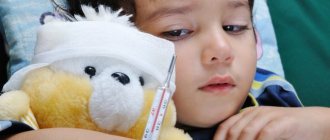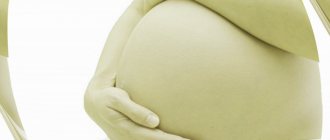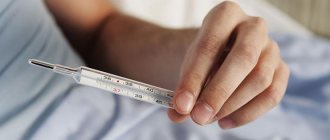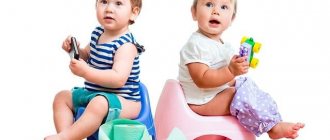Note to parents: temperature during sleep in children under one year old
The body temperature standard of 36.6 cannot be applied to very young children. Why does it change in children during sleep and wakefulness?
Caring parents prepare in advance for the arrival of their long-awaited first child by choosing a comfortable stroller with a crib. However, pleasant purchases are only the “tip of the iceberg”, because the real preparation begins long before running around the shops. You will need knowledge to raise a healthy baby. Adults simply lack knowledge in the field of pediatrics; without it it will be difficult to cope. A high temperature after sleep causes panic, but for young children this is considered normal. The exception is in individual cases. How to distinguish them? To answer correctly, such knowledge will come in handy.
Temperature after sleep
If you measure the temperature of a baby, it will become noticeable that a different result is always recorded. For example, a mercury thermometer will show 36-37⁰, and such numbers are considered the norm for children of this age. If the mercury column exceeds these numbers, only then do they speak of the presence of an elevated temperature.
If the thermometer confirms suspicions that the temperature is higher than normal, first look for the reason in the thermometer. Of course, an electronic thermometer is much more convenient for mothers with small babies. However, only a mercury thermometer will show the exact result. If other thermometers are available, use them to rule out error.
The reasons lie both externally and internally. An overly warm blanket and an unventilated room come first. This is due to the fact that in children under three months of age, natural thermoregulation does not work well. To detect other reasons, the following circumstances are taken into account:
- How many months old is the baby?
- How often do parents record inflated results?
- How much exactly does the thermometer show?
- How does the child behave when he wakes up: is he capricious or calm?
- Are there additional symptoms indicating the disease?
Normal baby temperature
- 36 - 37.3 °C - in the armpit;
- 36.6 - 37.2 °C - oral temperature;
- 36.9 - 38 °C - rectal temperature.
In newborn children, the process of thermoregulation is not fully formed and heat transfer prevails over heat production (heat production), children often freeze, which is expressed in hiccups, cooling and blueness of arms and legs. Therefore, it is easy for infants to become overheated or hypothermic.
Video consultation: why newborns have a temperature of 37.1-37.3
Parents should know that under conditions of constant swaddling, thermoregulation mechanisms “do not start.” This delays the child’s adaptation to the natural environment and makes him susceptible to colds.
Maintaining a normal temperature in the youngest children is achieved through routine child care.
Body temperature is not the same for all children and fluctuates, as indicated above, from 36 to 38 degrees (depending on where we measure), plus it depends on many factors in the development and physiology of the child. To determine the optimal (normal) body temperature of your baby, it is necessary to measure it for several days in the morning, lunch and evening. In this way, parents will be able to establish an average stable temperature for their newborn baby.
Read how to measure temperature (in what place and with what thermometer)
Video: how to measure a baby's temperature
What temperature should a baby have at 2 months? How to save a child from fever?
Every adult knows that normal body temperature is 36.6 degrees. Any deviations in the direction of decreasing or increasing temperature conditions indicate the appearance of pathological processes in the body, which must be subjected to appropriate therapy as soon as possible.
In a newborn baby, body temperature conditions may vary, because the baby’s body is not yet accustomed to factors that are unusual for it, so it reacts to any discomfort accordingly. Parents should take the necessary measures in a timely manner if the child’s temperature “deviates” from the norm.
What temperature should a baby have at 2 months? What factors can influence the cause of a decrease or increase in temperature conditions?
Features of measuring baby's body temperature
In medical practice, there are 3 correct methods for correctly measuring temperature conditions:
- Oral – a thermometer is placed under the tongue of newborns.
- Rectally - the thermometer is carefully inserted into the baby's anus.
- In the armpits - the thermometer is carefully applied to the child’s armpits and clamped with a handle.
Of all the above methods of measuring temperature conditions, doctors do not single out any specific one. You can measure a child’s temperature in a variety of ways, but it is important to understand that the final readings will vary significantly.
The following indicators are considered the norm:
- When measured orally, the baby’s temperature is considered normal if it corresponds to 36.6 – 37.2 degrees.
- When measuring rectally in an infant, the norm will be readings corresponding to 36.9 – 37.4 degrees.
- When measuring temperature conditions in the armpits of newborns, the norm was determined to be 36 – 37.2 degrees.
How to correctly measure the body temperature of a newborn?
Most often, parents prefer to measure their child’s body temperature in the armpits. To get the right result, you must follow important rules:
- The child should be calm when measuring the relevant indicators.
- The ideal time to measure is when your baby is fast asleep.
- It is important to remember that the normal temperature of a baby can vary depending on the influence of external factors. For example, if a newborn is frozen, then, accordingly, the final results of his temperature conditions will be underestimated. Conversely, if the baby is wrapped too warmly, then parents should not be surprised if the corresponding indicators become overestimated.
- The ideal position for measuring body temperature is the baby lies on its side, the thermometer is between the handle and the body.
- How long should you keep the thermometer? Depending on the type of thermometer, the duration of contact with the body may vary. Using a regular mercury thermometer, the temperature must be measured for at least 5 minutes.
Ways to maintain normal body temperature in a newborn
The smaller the child, the more he needs to create a special thermal regime. There are simple ways to create a comfortable environment for your child.
- The children's room should be well heated from 20º to 24ºС .
- An infant should be dressed in one more/less layer (depending on the season) than an adult would be dressed under given conditions.
- Make sure your child doesn't get cold at night. Cover it with a natural blanket (wool, cotton), which better retains heat while ensuring proper thermoregulation.
- When walking outside, an infant should be dressed appropriately for the season and the weather. It is important that the baby's head is kept warm to avoid hypothermia, because Almost 30% of heat is lost when the head is open.
- At first, it will be wise to use a simple wall thermometer in the room to determine the temperature in the room (See the article on the optimal temperature in a newborn’s room).
- To make sure your baby is warm, touch the back of his head with your palm. If the back of the head is cool, then the baby needs additional warmth.
How to prevent your baby from overheating
At the same time, parents must be careful to prevent the baby from overheating, because... Infants suffer overheating much more severely than hypothermia.
Normal body temperature is determined by a warm body, pink skin, and activity of the child. If parents notice a decrease in the child’s activity, lack of appetite, or an increase in temperature (especially if such signs occur during the warm season), the baby may have overheated. (In particularly severe cases, overheating can even lead to death.)
To prevent overheating, use the following methods:
- The baby should be dressed appropriately (in summer, a cotton shirt and a sheet for covering will suffice).
- Provide your child with plenty of fluids.
- In hot weather, do not take your newborn out into the open sunny space, try to walk with him in the shade.
- Place a Panama hat on your child's head.
- Do not leave your child unattended in the stroller for naps in the summer, as the sun can heat not only the stroller, but also overheat the child.
- NEVER leave an infant alone in a closed car.
Each child is individual and the normal temperature for each infant may be different. If the child is active, healthy, eats well and does not experience any discomfort, then there is no reason to worry!
Well, if your child has a high temperature, then read the articles:
- What to do and how to lower the temperature?
- How to reduce a baby's temperature at home using folk remedies
- An infant has a temperature of 37 - should I worry?
- Temperature after vaccination
- Medicines for fever for children
Temperature in newborns and infants
The condition of a newborn baby can be determined by several criteria: appetite, sleep, behavior. Among the main indicators of a healthy body is a normal temperature in an infant. It is not the same as in an adult and depends on many factors.
Normal body temperature for a 2 month old baby: what it should be, table
What should a child's temperature be at 2 months? This is a question many young parents ask. Particularly worrying is an increase above 37°. Should you worry if your baby is only two months old and has a fever? This is discussed in this article.
Baby's temperature
Body temperature in infants
The temperature of newborn babies can vary. However, it should not be increased or, conversely, decreased. Many factors have an influence. Since the thermoregulation of a child’s body in the first months of life is not yet stable, it reacts to any external factors and even to the psychological state of the baby.
Increases or decreases in temperature can occur due to weather changes or an unstable atmosphere at home. There are special tables that indicate the normal value of body heat for a newborn at different periods of life.
Something to remember! They describe only average values; in most cases, the normal value is determined individually. For some people, it is absolutely normal to be 1 degree higher or lower.
Normal temperature at 2 months
Parents should understand that for a two-month-old baby, a slightly elevated temperature is a natural phenomenon. To accurately determine the average value, you should take measurements every day for a certain period and record the result.
The indicator can vary from 36 to 38 degrees. Equally important is how the measurements were taken. The average value may vary in different locations on the baby's body.
Important! Not only the thermometer reading matters, but also the overall condition of the baby. If a two-month-old child’s temperature is higher than 37, but at the same time he behaves calmly, eats, does not express anxiety and sleeps soundly, then there is no reason for unnecessary worry.
Temperature depending on measurement location
Doctors suggest taking measurements in three main ways:
- The first is orally, when the thermometer is located under the tongue;
- The second is rectally, inserted into the anus, as carefully as possible;
- The third - under the armpits, the thermometer is carefully placed in the armpit and held.
When measuring your baby's temperature, you should use an electronic device. Experts do not single out any of the presented methods as more effective. All of them are used, here we should talk more about convenience.
Oral measurement
A newborn baby has unstable thermoregulation. Breasts are generally unable to control and regulate their own body heat and react to any changes, both on the street and at home. Therefore, you should properly care for your baby, avoiding overheating or hypothermia.
Important! In the first week of life, a baby may rise to 39 degrees, but don’t be alarmed. This is how the adaptation period passes after the mother's womb.
Table of temperature norms for a 2 month old baby
Measurement locationValue fromValue to
| Oral | 36,5 | 37,3 |
| Rectally | 36,7 | 38 |
| Armpit | 35,9 | 37,5 |
In general, the temperature of a 2-month-old baby can vary from 35.4 to 38.4 degrees. Changes in values in infants are natural and occur depending on physical characteristics.
How to measure a newborn's temperature
What temperature should a child have at 3 months?
Most mothers prefer to take measurements through the armpit. To ensure that the readings are as accurate as possible, the following rules should be observed:
- Measurements are taken when the child is calm and not crying;
- It is best to take the temperature while the baby is fast asleep;
- Before inserting the thermometer, wipe it with a damp cloth;
- The most comfortable position for measuring the indicator in the armpit is when the child lies on his side;
- The holding time of a thermometer depends on its type. The mercury is kept in contact with the body for at least 5 minutes;
- Measurements are not taken after walking, eating or swimming - the indicators will not correspond to reality. It's better to wait half an hour;
- Also, you should not measure the temperature if the child is crying or has just calmed down - the data will be overestimated.
Axillary measurement
Rules for taking measurements using the rectal method:
- A special children's thermometer with a soft tip is used;
- The tip is lubricated with cream;
- The child is placed on his side, his legs are bent at the knees;
- The thermometer is inserted and removed carefully.
Note! If the child refuses to fall asleep and the temperature needs to be measured, the mother should take the baby in her arms, try to calm him down, and pat him on the head.
Ways to maintain normal body temperature
When to lower your child's temperature
Having determined what body temperature a two-month-old baby should have, parents should think about creating a comfortable environment to maintain it. Why is this necessary? First of all, for the health of the baby, creating a comfortable atmosphere for him to sleep, relax and develop.
Simple conditions to follow:
- There should be no drafts in the room where the baby sleeps. The air warms up to 20-24 degrees;
- Depending on the season and time of year, an infant is dressed in 1 layer more or less clothing than an adult would be dressed in the same conditions;
- For walks in the fresh air, be sure to choose the right clothes. The baby's head is covered with a cap, since most of the heat is lost through the head;
- A regular or electronic thermometer is suitable for determining room temperature. This will make it easier for parents to navigate;
- You can determine whether your baby is warm enough by simply touching the back of his head. If it is cool, the child should be insulated.
It is equally important to ensure that the baby is not too hot. Overheating is tolerated by newborns much more severely than cold. The main external signs of normal body temperature in a baby are pink skin color, active behavior, normal nutrition and sleep.
Ways to prevent your child from overheating:
- Weather appropriate clothing;
- Drink plenty of fluids;
- On hot days, the baby should be protected from exposure to direct sunlight;
- The baby's head should be covered;
- A child should not be left unattended while sleeping in a stroller or car. This is dangerous and can lead to irreparable consequences.
Reasons for temperature rise above normal
What to do if the baby does not eat
If your baby is in his second month and has a fever, this is not yet a cause for concern. However, parents should make sure that the child is not in danger. What could be the reasons for an increase in the indicator above the norm:
- The clothes, diaper or blanket are too warm or do not match the time of year and temperature in the house where the baby is;
- The indicator may increase sharply if the baby has been in direct sunlight for a long time or in a stuffy room, for example, in a car;
- The child's body receives too little fluid. Contrary to the opinion of some mothers, newborns need water; its lack can lead to a sharp rise in temperature;
- Intestinal obstruction, or simply constipation;
- Emotional overexcitement. Long or fun games, a trip, long communication with relatives can affect the unformed child’s psyche and lead to the following consequences;
- Teething – in this case, an increase in temperature is a symptom. In addition, the baby will cry, refuse to eat, and not sleep. There is also increased salivation;
- Recently vaccinated.
All of these symptoms can lead to an increase in the reading to 37.8 degrees. However, if there are additional symptoms that cause concern to parents, for example, rashes on the body, you should not delay visiting a doctor.
Baby needs enough fluids
First aid for a newborn with fever
If the indicator increases not due to a natural process, but as a result of a disease, do not panic. First of all, you need to understand that during an illness an increase of 1-1.5 degrees is normal, indicating that the body is fighting the disease.
Most doctors do not recommend lowering the temperature if it is below 38.5 degrees. In each individual case, it is necessary to monitor the baby’s condition. If the child behaves actively and does not refuse food, then there is no need to panic. However, some children have a hard time even with a reading of 37.5 during illness. How can you help your child in this case?
If your child has a serious fever, it is better to immediately call an ambulance. Before arriving, use proven folk remedies. The baby should be undressed, even removing the diaper, and wet his arms and legs with a cool, damp towel.
Antipyretics are prescribed by specialists. As a rule, these are syrups containing Paracetamol; candles are inserted into the smallest ones.
Important! A newborn should not be given medications not prescribed by a doctor. Moreover, you should not give out medications that are not suitable for the baby’s body.
So what is the normal temperature for a baby at 1 or 2 months? First of all, this indicator is determined individually, but on average it ranges from 36.4 to 37.7 degrees. It is very important to monitor the baby’s condition, his nutrition and weight gain.
If the child does not show visible anxiety, is cheerful, playful, eats happily and sleeps soundly, then there is no need to worry. Moreover, you should not give your child any medications without first consulting a specialist.
Source: https://kpoxa.info/zdorovie-pitanie/kakaya-temperatura-rebenka-2-mes.html
What indicators are considered normal?
Thermoregulation processes continue to develop in children until the end of the first year of life. Accordingly, the temperature by this time will be the same as in adults (36.6 degrees).
In the first month, the child’s body temperature ranges from 37 to 37.5 degrees. In subsequent months, the normal level decreases and can range from 36 to 37 degrees.
Temperature in children can be measured in several ways and using various thermometers (electronic, infrared, mercury). The answer to the question of what temperature is considered normal for children under one year old depends on the place where the measurement takes place.
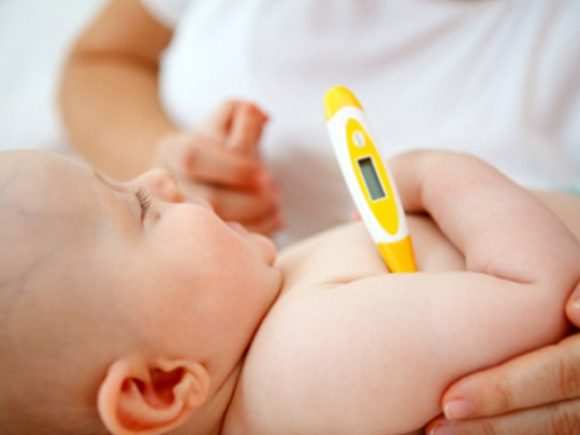
- In the axillary region, 36–37.3 degrees is considered normal.
- Oral temperature ranges from 36.6 to 37.2.
- Rectal temperature can be higher - from 36.9 to 38. This method of measurement is used when the baby can lie quietly for several minutes. Otherwise, the intestinal walls may be damaged. The number 38 on the thermometer is considered normal if the child feels well.
Since the heat exchange process has not yet been established, it is very easy for a baby to cool down or overheat. It is very important to monitor the temperature and humidity in the room . You should not wrap your child up too much. All these factors influence the temperature level of the body.
To determine what temperature is normal for a child, you should measure it every day for several days at the same time. You should not measure the temperature immediately after waking up, after eating, crying, or after the baby is active. You can keep a diary of observations.
Causes of hypothermia
A child's low temperature of 36.1, 36.2, 36.3 or 36.4℃ can be explained by various processes and arise for a number of reasons. Most often, the culprits of hypothermia are physiological or psychological factors, as well as the body’s thermoregulation, which is very different in children of different ages.
We should not forget that temperatures ranging from 36.0 to 36.4℃ may indicate any disturbances in the child’s development, which caused a decrease in body temperature.

How to measure temperature correctly
If a mercury thermometer is used, then it should only be used to measure in the armpit area. After the sixth month of life, temperature can be measured while sitting. Be careful not to let the thermometer fall. Mercury is dangerous to the human body; damage to the thermometer should be avoided. It will take 5–7 minutes to obtain a reliable result.
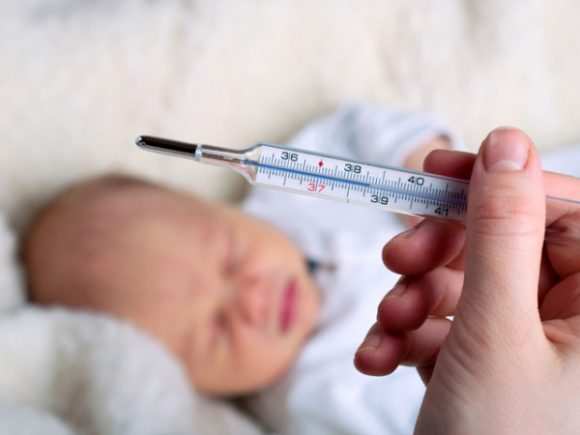
The electronic thermometer is simple and safe to use. It can be used from the first month of a child’s life. An audible timer will signal the end of the measurement procedure. This takes up to 3 minutes. Accurate readings can be achieved through oral or rectal administration. If you install it in the armpit, the result will fluctuate within a few degrees.
For oral use, the tip of the thermometer is placed in the mouth under the tongue. 1 minute is enough.
Rectal insertion will require more preparation. The child is placed on his side, his legs are bent to his tummy. The tip of the thermometer is lubricated with baby cream. After this, it is carefully and carefully inserted into the anus, no deeper than 2 cm.
The temperature indicator is a small strip with divisions that is applied to the child's forehead for a few seconds.
Dummy thermometer. This thermometer is very convenient for measuring the temperature of children under one year old. But it can be used if the baby is accustomed to a pacifier.
How to maintain your baby's temperature at the same level
In order for the baby's body temperature to be equally normal - 36.6 degrees or slightly higher, you should follow simple hygiene rules.
- The temperature in the room where the baby is located should be 20–24 degrees. It is better to hang the thermometer directly above the baby's crib. If a child is born prematurely or has a cold, the temperature in the air increases. In hot weather, the temperature should be slightly lower (up to 18 degrees).
- You shouldn't wrap your baby up too much. Clothes must be of high quality and breathable.
- During the walk, children's heads should be covered. Most of the heat leaves this part of the body.
- You can determine whether a child is hot or cold by looking at his condition. Skin color (red or vice versa, marbled), tactile sensations (cold hands or the presence of sweat), the appearance of hiccups or goose bumps.
- During the hot season, children should drink as much as possible to prevent dehydration.
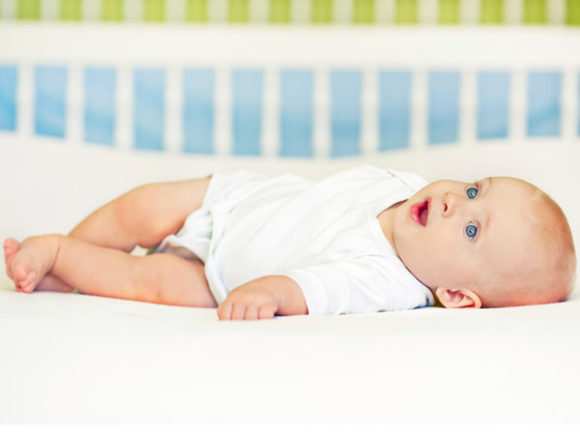
What causes the temperature to rise
An increase in temperature is a consequence of some provoking factor. Children under 3 months of age should not lower their body temperature below 38.2 degrees. The thermoregulation process can be disrupted. But this is only if the baby feels relatively well. If convulsions appear, he becomes lethargic, or loses his appetite, you should consult a doctor.
The reason for the increase in temperature may be:
- Viral and bacterial infections. In this case, there will be other symptoms: cough, redness of the throat, runny nose.
- Stressful situations.
- Overheat. Long exposure to the sun, improper dressing.
- Active games or long crying.
- The cause may be teething.
- A high temperature may be the result of an intestinal infection or a cold.
- The temperature of children under one year of age may increase after vaccination.
In the event that an elevated body temperature persists for three days, if it reaches 39 degrees or higher and is not reduced by antipyretics, you should immediately seek medical help. When it’s hot, the body’s tissues stop receiving oxygen, and the defenses weaken, which is a very dangerous condition.
An ambulance should be called in cases where the following symptoms appear:
- A child under three months of age has a fever.
- The baby's temperature is above 38.5 degrees.
- Convulsions appeared.
- Tension in the cervical spine, it is impossible to bend the head forward.
- Breathing becomes noisy and frequent.
- The child constantly cries, while he is lethargic and apathetic.
- Refusal to eat.
- There is frequent vomiting and diarrhea.
- Problems with urination or urine color.
- The appearance of a rash on the skin.
- Presence of chronic diseases.
- Inability to reduce fever with antipyretics.
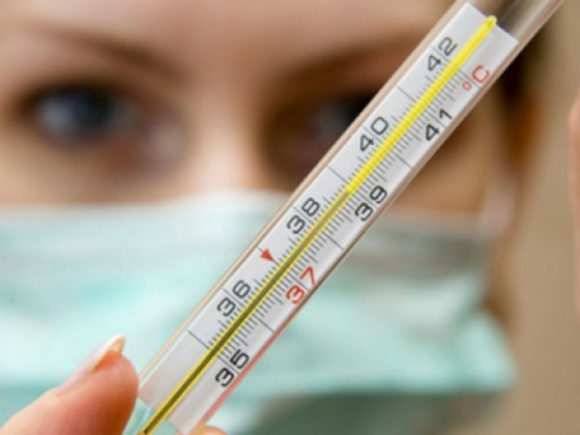
Before the doctor arrives, you should follow a few simple recommendations.
- The baby should be given as much fluid as possible.
- The children's room needs to be ventilated. The child should be moved to another place for this time.
- The light should be dim. No harsh sounds.
- You can apply compresses to your legs. The towel is moistened in water (about 20 degrees) and applied to the feet.
- You can't wrap up a child.
If children's body temperature decreases, but only slightly (up to 35 degrees) and they feel well, then there is no need to worry. Perhaps this is an individual characteristic of the body. If the value drops below 35, they speak of hypothermia. You should consult a doctor. He will order additional examinations. You will need to consult a pediatrician, endocrinologist, or immunologist.
Reasons for a decrease in body temperature in a child under one year of age:
- In children born prematurely.
- During sleep.
- Against the background of a long-term illness, the body’s defenses weaken.
- Vitamin deficiency, anemia.
- Hormonal imbalance.
- While taking antipyretic drugs.
- Malignant formations.
- Hypothermia.
- After severe poisoning.
If the decrease is associated with hypothermia, then the child should be warmed up (warm drink, warm clothes, you can apply a heating pad to the legs). It is important to harden and increase immunity.
Safe Causes of Hypothermia
The reason why a child may have a low temperature can be either neutral or negative. The nature of hypothermia determines whether treatment is needed or not.
- Unformed thermoregulation . In children under 2 years of age, thermoregulation, as a rule, is not yet complete, which means that when the ambient temperature changes, the body temperature may vary, but the child will feel great. For example, during winter walks, a baby’s hypothermia can drop to 36.1℃ and below, but when placed in a warm room, it normalizes in a short time.
- Prematurity and low weight . As a rule, all premature and low birth weight babies have a low temperature of 36.1℃, and this is normal. The occurrence of hypothermia in this case can be explained by the fact that the child, due to his low weight, cannot hold the number sufficiently, as a result of which he is exposed to hypothermia. Maintaining the temperature within normal limits is very important for such babies, and the advice of your local pediatrician will help you do this.
- Physiological reasons . A low temperature may be due to the physiological characteristics of each child. Throughout the day, the baby's temperature can jump from 36.1℃ to 36.9℃, and at the same time the child will behave quite normally. It reaches the lower limit of 36.1℃ early in the morning, and rises to 36.9℃ only in the late afternoon. In such cases, it is recommended to measure the child’s body temperature in the middle of the day.
- Reaction to vaccination . If your child has been vaccinated, there is a good chance that over the next few days the child will have a low temperature ranging from 36.1℃ to 36.4℃. This is explained by the fact that most vaccinations affect the child’s immunity, and hypothermia is a common occurrence.
- Consequences of the disease . Temperatures of 36.1, 36.2, 36.3, 36.4 and 36.5 may be observed in a child after an illness. In most cases, in children after illness it can decrease from 36.1℃ to 36.4℃, in some cases it can fall below 36.0℃. The reason is that after an illness, the body spends all its energy trying to restore a weakened immune system. During this period, it is extremely important not to expose children to high and low temperatures until the body has fully recovered.
- Overwork . Very often, the cause of hypothermia in the range from 36.1 to 36.5℃ can be normal fatigue. Children of preschool and school age suffer especially greatly from this, since due to unaccustomment to intense physical and mental stress, the body does not have time to adapt.
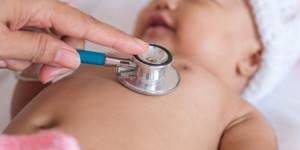
Any of the above reasons can cause a decrease in the temperature of a child’s body, and the sooner the cause can be identified, the faster it will normalize to the standard 36.6℃ or slightly higher.
Many parents know how to act if their child has a high temperature, but few know how to act in case of hypothermia. It requires that the child be dressed warmly and not be in the cold for a long time.
When to take your temperature
There is no need to measure the body temperature of children under one year old without any reason. This is stressful for them. But the procedure will be necessary if alarming symptoms appear:
- Excessive anxiety, lethargy, moodiness.
- Increased need for fluid.
- Dry mouth and lips are observed.
- Pulse and breathing become frequent and intermittent.
- The cheeks become very red or, on the contrary, pale.
- Chills appear, blurred vision.
A child under one year old requires increased attention from adults. Any failure to comply with hygiene standards can lead to a malfunction of the body. This causes the occurrence of various diseases.
The ideal indicator of normal human body temperature is 36.6 degrees. We start from it when measuring our own temperature during illness. Fluctuations in the indicator in a healthy state of the body depend on the individual characteristics of people. The rate of metabolism, heat transfer, heat production, temperature of the external space - all these processes affect the final indicators. The picture of normality in a child is even more complex. When measuring the baby’s body temperature, parents must take into account many factors: whether the child was active before the measurement, what he was wearing, when he ate. In addition, the thermometer readings also depend on the individual thermal reaction of the child’s body.
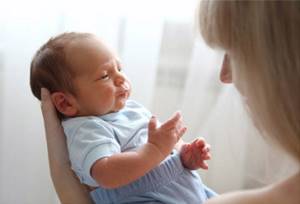
If with an adult everything is more or less clear, then in a newborn the body temperature is a very flexible value. It even depends on factors such as food, activity, sleep duration and emotional state. What is the body temperature of a newborn?
Within a few minutes of leaving the womb, the newborn has the same body temperature as the mother. Adaptation to the new environment causes a decrease in the initial numbers by 1-1.5 degrees in a month-old baby. It is important that hypothermia is prevented already in the first hours of the baby’s appearance. After 5-6 hours, the numbers reach an average value and fluctuate between 36.5-36.8 degrees. It is possible to increase to 37.0 degrees in the first seven days of a child’s life.
With transient hyperthermia, the newborn’s temperature rises sharply to 38-39 degrees on days 3-5 after birth. The cause of the disease may be too warm air in the ward, or the close location of the pump room next to the heating equipment. The occurrence of the disease is influenced by lack of drinking in hot weather, the child being in direct sunlight, and overheating due to warm clothing. Treatment of transient hyperthermia consists of eliminating the factors that caused it. The child is undressed and allowed to lie naked so that the body cools down. Increase the amount of drinking (give 50-100 ml of 5% glucose solution).
If transient hyperthermia occurs in 0.3-0.5% of children, then the opposite effect in the form of hypothermia (lower temperature) is diagnosed more often. Doctors trace the connection of hypothermia with anatomical and physiological differences in the child’s body and new living conditions for newborns. For the first 2 months, newborns do not have the daily temperature rhythm inherent in adults. After two months it begins to form, but even then it is weakly expressed.
A short-term rise from average to elevated levels is rarely associated with the penetration of infection into the baby’s body. The degrees may increase if the child cried for a long time or was actively awake; even eating sometimes causes a jump. The gradual development of heat transfer and heat production processes in the first 4-5 weeks of a child’s life requires a special approach to his clothing. It is preferable to swaddle the baby rather than put baby undershirts and rompers on him.
Norm for children from 2 months of age to 5-7 years
The question of what temperature is considered healthy for a child aged 1 month worries many parents (what to do if the child has a low temperature?). Pediatricians are guided by average indicators obtained as a result of long-term observations of infants. In order not to create unnecessary reasons for worry, write down the standard numbers for yourself:
- for the armpit – 36.4-37.3°C;
- for the rectum (rectal) – 36.9-37.6°C;
- in the mouth (oral) – 36.6-37.2°C.
Intervals are given taking into account the individual characteristics of children. To find out what marks on the thermometer will be normal for your child, you should measure him 3 times a day for several days. Write down what the degrees were in the three zones and show them to the pediatrician. The doctor will calculate the average value for your child and determine his individual parameters of heat transfer and heat production. Knowing how the baby’s body behaves, you can easily distinguish the norm from the problem that has arisen.
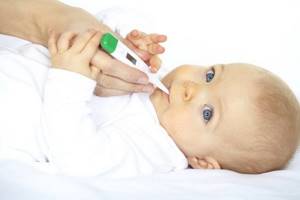
Body temperature can be measured in different ways, but its indicators differ slightly. If the mother is worried, she can choose a method suitable for the baby and measure the temperature over several days, making a schedule
Starting from the second month and up to six months, the temperature of an infant, measured in the armpit, can rise to 37.4 degrees - it is considered normal. After 6 months, the upper limit should not exceed 37 degrees. While actively developing, a child expends a lot of energy, so do not be alarmed if his temperature rises a little. An increase to 38°C both at 2 days and at 2 years can be observed during a long, hysterical state with crying or severe overexcitation. The jump is caused by an abundant rush of blood to the baby's head. In addition, an increase in digital values not associated with a disease can be caused by:
- colic;
- overheating (hot in the bathroom, indoors or outdoors, warm clothes);
- growth of the first teeth;
- the body's reaction to the vaccine;
- allergies.
We measure the temperature correctly
It is preferable to measure the temperature of an infant when he is sleeping. The calm state of the child allows you to get accurate numbers. It is recommended to take measurements during the waking period 30 minutes after you have walked with the child, fed or bought him. Before placing the thermometer, you need to wipe the skin.
- For children under 4 years old, the thermometer is placed vertically in the axillary area, with the tail in the armpit and the scale clamped between the inner surface of the arm and the side of the body.
- For a 4-5 year old child, the thermometer is placed in the same way as for adults.
If it is necessary to measure the temperature rectally, the baby should be placed on its side, asked to bend its legs at the knees and pull it towards the body. The tail of the thermometer must be lubricated with Vaseline or baby cream and carefully inserted into the anus. Having completed the measurement, the thermometer is also carefully removed from the rectum and the mark is observed.
A mercury thermometer is not used to measure rectal temperature; you should take an electronic device with a soft tip.
Dr. Komarovsky points out that a temperature of 36-37 degrees is considered normal for a child. By taking measurements throughout the day, you can control it, understanding whether your baby is healthy or whether there are signs of problems in the body. Please also take into account the fact that in the morning after a restful sleep the temperature drops, and in the evening it may be slightly elevated. The difference is 3-4 thermometer divisions. For the morning the norm will be 35.9-36.1°C, in the evening - 36.9-37.3°C.
A child in a family is always a great joy. Caring for it is a whole science. In the modern world there is a lot of literature on this issue. But young parents do not always understand everything that concerns their own children. Is the child cold or hot? What is the normal body temperature of a newborn?
Our article will reveal all the secrets of thermoregulation in babies. Together with you, we will find out what the normal temperature is for children under one year old.
Normal temperature in an infant: normal from 1 month to 4 years
The normal temperature of a baby differs from that of an adult. Thus, before buying antipyretics, you should understand what temperature standards exist for children of different ages, and what can cause the temperature to rise. Indicators above 36.6°C do not always indicate the presence of pathological processes and are a cause for concern.
Normal temperature for infants up to one year old
Young parents want to know what temperature is considered normal for their baby. This indicator depends on many factors, one of which is age. For example, normal temperature readings for a three-month-old child will differ from those considered normal for a one-year-old child. In addition, each part of the body has its own temperature.
There are 2 concepts: core and periphery temperature. The core refers to internal organs with good blood supply; there can be readings up to 38°C. The periphery is the limbs, where the temperature can rise to 27°C.
Normal indicators in places where it is customary to measure temperature may be as follows:
- armpit – 36.6…37.4°C;
- oral cavity – 36.7…37.3°C;
- rectum – 36.8…38.1°C.
Since a one-month-old baby’s temperature should be at least 37°C, and for example an 8-month-old baby’s temperature should be 36.6°C, it is worth considering a detailed table of temperature fluctuations in infants under one year of age:
| Age | Indicators, in °C |
| 1 month | 37…37,7 |
| 2 months | 36,9…37,5 |
| 3 months | 36,8…37,6 |
| 4 months | 36,7…37,6 |
| 5 months | 36,6…37,6 |
| 6 months | 36.6…37.6 C |
| 7 months | 36,6…37,5 |
| 8 months | 36,6…37,5 |
| 9 months | 36,6…37,4 |
| 10 months | 36,6…37,2 |
| 11 months | 36,6…37 |
| 1 year | 36,6…36,9 |
The values are taken into account provided that the baby feels well and has no nasal discharge.
To keep your baby's temperature within normal limits, you should follow simple rules:
- The temperature in the room where the baby is located should be within +20...+24°C. To monitor the indicators, it is worth hanging a thermometer above the arena. If the baby was born premature or has a cold, the air temperature should be higher. In hot weather, the readings may be slightly below +18°C.
- The baby should not be wrapped. Clothes must “breathe”.
- During the walk, the baby's head should be covered. Most of the heat leaves this part of the body.
- You can determine whether a baby is hot or cold by looking at its condition. Skin color (red or marbled), tactile sensations (presence of sweat or cold hands), the appearance of hiccups or goose bumps.
In hot weather, you should give your baby more to drink to prevent dehydration, which leads to overheating.
Normal temperature in children after one year
The normal temperature of a one-year-old child is already close to that of an adult, but an increase in values to 37°C is not considered dangerous.
Thermoregulation in children is fully formed by the age of 2 years. However, even before 5 years of age it is subject to daily fluctuations. For this reason, you should not worry too much about small temperature fluctuations in a child at 3-4.5 years old.
Such fluctuations are due to the following reasons:
- In half of the children, the measurement results in the left armpit are 0.2-0.5°C higher than in the right. Most likely because the left one is closer to the heart.
- In children from 2 to 5 years of age, daily changes are observed: at 16-17 hours the indicators are the highest, 4-5 hours - the lowest. The difference is from 0.6 to 1°C.
- For overweight and active children at 2.5 years old, the norm is 0.2-0.4°C higher than for thin and not very active children.
At rest, at 11-14 hours, 40 minutes after eating, the norm for 2-year-old children ranges from 36.5...36.9°C. At 5 o’clock in the morning – 35.8…36.6°С.
Reasons for deviations from the norm
The reasons for the temperature deviation may be different. These are not always diseases that require treatment. An increase in temperature, for example, accompanies the period of teething.
A 4-month-old child’s temperature may rise due to overheating or being in a stuffy room. Indicators may increase after eating, a stressful situation, and even a noisy game.
For this reason, you should alternate vigorous activity with quieter activities - drawing, reading books, etc.
The causes of hypothermia (decreased performance) often indicate pathological processes in the child’s body, although they can also be a consequence of even slight hypothermia.
Fever
With elevated levels, the baby refuses food, begins to cry, and his breathing quickens. He may turn red and the body becomes wet. In this case, the limbs may remain cold due to poor circulation.
There are many reasons for the increase in temperature, one of them is a reaction to vaccination. To form the body's defenses, a small portion of the antigen is introduced, with which the child's body fights, developing immunity to this disease. This type of immune function is most often accompanied by an increase in temperature.
The intensity of the reaction depends on 2 factors:
- individual characteristics of the body;
- the amount of antigen and the degree of its purification.
After immunization, the indicator may rise to 38.5°C. This reaction may appear some time after vaccination. If the temperature rises above 39°C, you should seek medical help.
There are asymptomatic causes of increased temperature readings. They are difficult to diagnose, so you should pay special attention to them:
- the presence of foreign bodies in the body;
- allergic reaction to objects that the baby comes into contact with;
- congenital heart disease, tumors, diseases associated with the endocrine system;
- headache.
In order not to miss severe pathologies with a systematic increase in temperature, you should immediately consult a doctor.
Overheating is a common cause. Even if the room is cool, but the child is tightly bundled up, he may overheat. It is better to take off your hat indoors.
Constipation and teething often lead to a slight increase in readings. In the second case, inflammation of the gums leads to an increase in temperature.
In infectious diseases, an increase in temperature is associated with the effect on the body of metabolic products and decay of pathogenic microorganisms. The duration of fever most often coincides with a period of intensive reproduction of harmful microbes in the body.
Reduced body temperature
A decrease in temperature is accompanied by paleness of the skin, and the lips and adjacent skin acquire a bluish tint. The baby may begin to swing its upper and lower limbs sharply and scream loudly.
If the temperature drops slightly (up to 35°C), and the baby feels well, then there is no need to worry. This may be an individual characteristic of the body.
If the value drops below 35°C, this indicates hypothermia. In this case, you should definitely consult a doctor and conduct an examination.
Most often, consultation with a pediatrician, immunologist and endocrinologist is required.
The reasons for a decrease in temperature in infants up to one year old may be as follows:
- premature birth;
- during sleep;
- against the background of a long illness;
- lack of vitamins, anemia;
- hormonal imbalances;
- after taking antipyretic drugs;
- presence of a tumor;
- hypothermia;
- severe poisoning.
If the decrease was the result of hypothermia, the baby must be warmed with warm drinks and clothing, you can put a heating pad at the feet. To avoid this phenomenon, you should maintain the required temperature in the room where the baby is located and harden the child to increase immunity.
How is high temperature treated in infants?
Pediatricians do not recommend reducing fever if the thermometer shows 38.5°C or lower. When a harmful microorganism enters, the body itself is capable of producing interferon. The maximum concentration of the substance occurs on the 2nd day of disease development. If you actively reduce the fever during this period, the child’s immunity decreases, and the disease only progresses.
To lower the temperature in a child under 1 year old, the following principles should be followed:
- Create comfortable indoor conditions (no more than +20 °C).
- Moderate dressing or swaddling (the baby should neither sweat nor become cold).
- Provide plenty of fluids.
- Avoid excessive physical activity.
If the readings do not fall below 38.5°C, it is recommended to give the patient medications that reduce febrile symptoms. The safest are paracetamol-based drugs. If these remedies do not help, then ibuprofen-based medications are used.
Temperatures should be lowered with medications with caution. The dosage of drugs to reduce fever in a 3-month-old child is less than in a six-month-old baby.
It is necessary to call an ambulance in the following cases:
- a fever occurs in an infant under 3 months of age;
- on the thermometer 38.5°C and above;
- the appearance of seizures;
- tension in the cervical spine (the child cannot bend his head forward);
- noisy and rapid breathing;
- the baby cries constantly;
- refusal of food;
- vomiting and loose stools;
- change in urine color;
- rash on the skin;
- the presence of chronic pathologies;
- the temperature is not reduced by antipyretic drugs.
Before the ambulance arrives, you need to adhere to the following recommendations:
- give as much fluid as possible;
- ventilate the room where the child is (at this time, move the baby to another room);
- apply cooling compresses to your feet.
- do not wrap the baby.
Dim the lighting in the room, eliminate harsh sounds and any situations that could cause stress in a small patient.
What to do if your baby has a low temperature?
When the body temperature is below the permissible norm, the child becomes lethargic and capricious. To normalize his condition, it is necessary to carry out a number of measures:
- Insulate the child. Make sure that things and bedding are dry.
- Ensure the required temperature in the room (at least +20°C).
- Maintain a sleep schedule. Infants need to sleep at least 10 hours a day.
If a low body temperature persists for a long time and is accompanied by a deterioration in the baby’s condition, this can negatively affect mental and physical development. For this reason, parents should not ignore even the slightest deterioration in the child’s well-being.
How to measure temperature correctly?
To obtain more accurate thermometry readings, measurements should be taken between meals, more than 1 hour after physical activity.
You should not check indicators in periods after:
- food;
- long walk;
- crying a lot;
- bathing;
- sleep.
The measurement process itself should not be accompanied by crying, screaming or resistance on the part of the baby. The generally accepted method of measuring temperature is using a mercury or electronic thermometer, placing it in the armpit.
The temperature is measured under the left armpit. It is advisable that the thermometer is not cold, otherwise the manipulation will cause a negative reaction in the child, which will affect the results. Before use, you can hold the thermometer in your palm for 3-5 minutes. Before placing the mercury thermometer, shake it so that the mercury column drops below 36°C.
The thermometer should be held under the armpit for 5-7 minutes. In the first 120 seconds, the mercury rises quickly; the subsequent rise will be slight. Therefore, 2 minutes is enough to roughly estimate the temperature. An electronic thermometer measures 1-2 minutes.
Sometimes the temperature is measured in the rectum (rectally). In this case, the normal limit is 38°C.
To do this, the tip is lubricated with Vaseline, the baby is placed on his stomach on the lap of his mother or father (school-age children are placed on their side with their knees pulled up to their stomach).
The measuring device is inserted into the anus to a depth of 2 cm; it needs to be held in this position for 1 minute (an approximate result will be available in 20 seconds).
A sick child's temperature must be measured 2 times a day - in the morning and at 16-17 hours of the day. In acute cases of the disease, body temperature is checked every 3-4 hours. Monitoring of indicators must be carried out until the temperature is completely normalized.
If excessive moodiness, crying for no apparent reason, depressed breathing, nasal discharge, lethargy and drowsiness have been noticed in the baby, this is a reason to put in a thermometer. Such manifestations may indicate the presence of an infection or other pathological process in the body.
Source: https://medru.su/deti/normalnaya-temperatura-u-grudnichka.html
The concept of thermoregulation
The human body is designed in such a way that our body temperature changes under the influence of the environment. This process is called thermoregulation. Its main center is located in the brain. In infants, this mechanism does not work entirely smoothly, so the baby easily becomes cold or overheats.
Two processes always occur in a child’s body: heat production and heat transfer. Heat production in babies works very actively. A child generates much more heat than an adult, but babies can hardly give off this heat, since their sweat glands are underdeveloped.
Komarovsky, pediatrician: “If the parents are warm, then it may well be that their baby is hot. Touch the back of the baby's head; if it is cold, the baby is cold; if, on the contrary, it is damp, then it is hot. A baby’s normal temperature fluctuates.”
In children of the first months, the source of heat is brown fat, which babies accumulate from the end of intrauterine life. Babies also cannot tremble, so when they freeze, they begin to actively move their arms or legs.
The subcutaneous fat layer is too thin. Because of this, the ability to retain heat inside the body is reduced. Sweating is poorly developed. The baby cannot properly give off excess moisture.
Indicators of the state of heat or cold in infants are the nose, hands and back of the head.
Cold sweat in a child - looking for the main causes of the disease
Body temperature is maintained by only two processes: due to the expansion of blood vessels and the work of sweat glands. “Stop running already, your whole T-shirt is wet” – a familiar phrase? During outdoor games, children sweat and this is perceived as normal. However, when this happens often, for no apparent reason, parents have no time for jokes. This type of sweat is also called cold sweat, as perspiration appears just like that. Is it really necessary to overreact to such cases?
Why do children have sticky sweat?
Human sweat consists of an aqueous solution of salts and organic substances. After it hits the skin, the water evaporates and the salts mix with the secretions of the sebaceous glands, forming a thin sticky film on the skin. It performs protective and moisturizing functions, but sometimes sticky sweat indicates the presence of pathologies in the body. Infants may sweat profusely due to:
- tension during breastfeeding;
- lack of vitamin D;
- pain during teething;
- diseases associated with impaired phosphorus-calcium metabolism.
Any infectious and inflammatory processes are accompanied by fever and a state of sticky sweat. In young children, seasonal ARVI and respiratory infections traditionally lead among the most frequently occurring ones.
Sweating as a symptom of emergency conditions
Cold sweating in a child occurs for various reasons, and is rarely associated with a painful condition. However, when symptoms are heard, sweating is a manifestation of:
- Hypoglycemia. In addition to sweating, the body trembles, the heartbeat quickens, and the skin turns pale. Although hypoglycemia is typical for people with diabetes, it sometimes appears in absolutely healthy children.
- Lack of oxygen (hypoxia). There are different types of hypoxia, the danger is acute, developing as a result of severe poisoning, allergy attacks and other conditions. Accompanied by pallor, dizziness, nausea, slow heart rate. In a serious and dangerous condition, there are only 2-2.5 hours to save a person.
- Decreased blood pressure. Occurs with an allergic reaction, concussion. Associated symptoms of hypotension are weakness, nausea, pallor, hands and feet that feel cold to the touch.
- Shock states. It can be anaphylactic, neurogenic, cardiogenic, etc. In such cases, sweat appears due to a sudden disruption in blood circulation.
- Other reasons. These include seasickness, severe pain shock, fainting, and repeated bouts of vomiting.
Why does a child have cold sweats and low temperature?
Any mother will be scared when she sees that the mercury has frozen at 36⁰. You don’t need to take the numbers critically right away, but after two or three hours the temperature readings will remain at the same level, look for the reasons. The most common are taking vasoconstrictors and antipyretics, exhaustion, and viral infection. Once the cause is determined, look for the following symptoms:
How to measure temperature?
To know the normal body temperature of a child, three measurements are needed - in the morning, in the evening and in the afternoon. You need to choose the average value.
Body temperature can be measured:
- in the armpit - the most common method;
- in the inguinal fold;
- in the mouth;
- in the anus.
A thermometer is required for measurement. You need to place it in the armpit and fix it with your hand for 5-10 minutes. If the child does not allow you to measure, then for at least two minutes. At high temperatures, the mercury thermometer will have enough time to warm up.
In the groin fold we do the same.
When taking the temperature in your mouth, never use a mercury glass thermometer. A child may break the tip.
When measuring in the anus, the thermometer must first be dipped in Vaseline. Then lift the baby’s legs and carefully insert the thermometer into the anus 2-3 cm. Measure for three minutes.
Normal temperature in a baby
An infant's temperature may change due to environmental conditions. The figure 36.6, which we are all accustomed to, cannot be attributed to children under one year old.
The body temperature of a newborn is considered normal:
- in the armpit - 36-37.5 degrees;
- in the anus - 1 degree more, that is, 37-38 degrees;
- in the mouth - 37.2 degrees.
As a result, the normal temperature range in a newborn is 2 degrees - 36-38 ˚С.
Types of thermometers
- Electronic . Safe to use. But he is not always accurate in his readings; there are errors of half a degree. After the measurement is completed, it emits a sound or light signal.
- Mercury . The most accurate. The mercury ball heats up and expands under the influence of high temperature and cools more slowly. The disadvantage of this thermometer is that it is easy to break. Or a child can chew it, and mercury is toxic.
- Infrared (rectal, ear, frontal). They measure the temperature tactilely, in the ear or by pressing it to the forehead. Its readings may be overestimated by half a degree.
- Dummy thermometer . A pacifier thermometer will be useful for those children who suck pacifiers and are capricious during the temperature measurement procedure. It comes with various funny designs on the ring.
Dr. Komarovsky: “In Russia, the main thermometer is a mercury thermometer. It's like a tradition passed down from generation to generation. The main thing is that the thermometer shows the exact temperature.”
Reasons for rising temperature
- The child is dressed warmly . The rule for dressing babies in cold weather is “+1 layer from an adult.” This means that you need to mentally add another layer to the clothes that you are currently wearing. In hot weather, the “-1 layer” rule applies.
- It's hot in the children's room . The optimal temperature at home is 20-24 degrees.
- Dry air, heaters on . They can also artificially overheat the air in a room.
